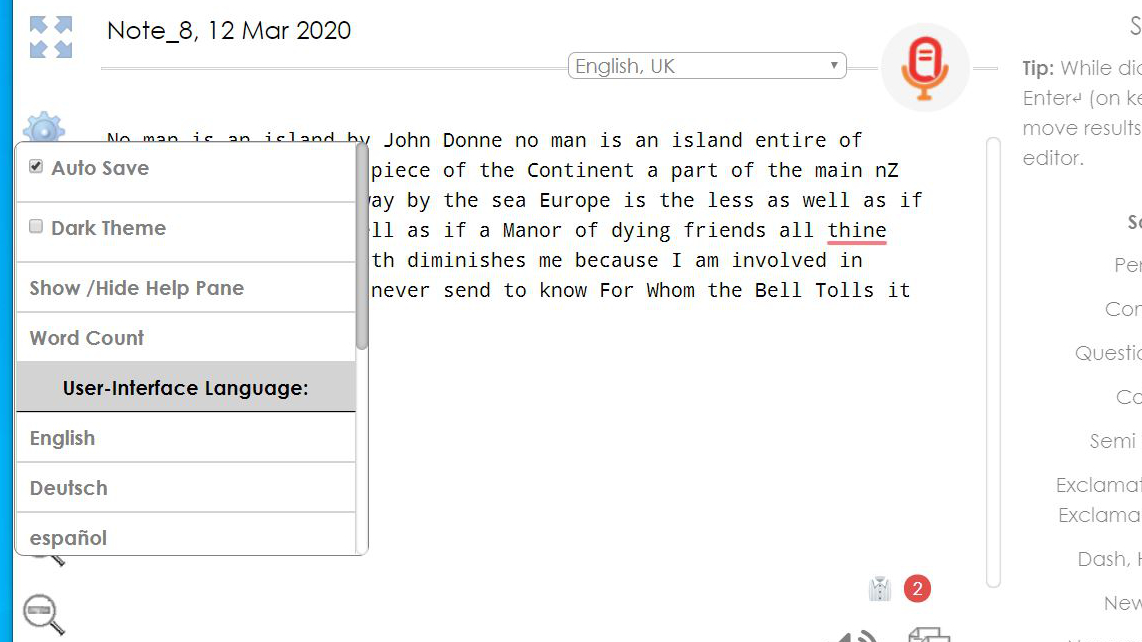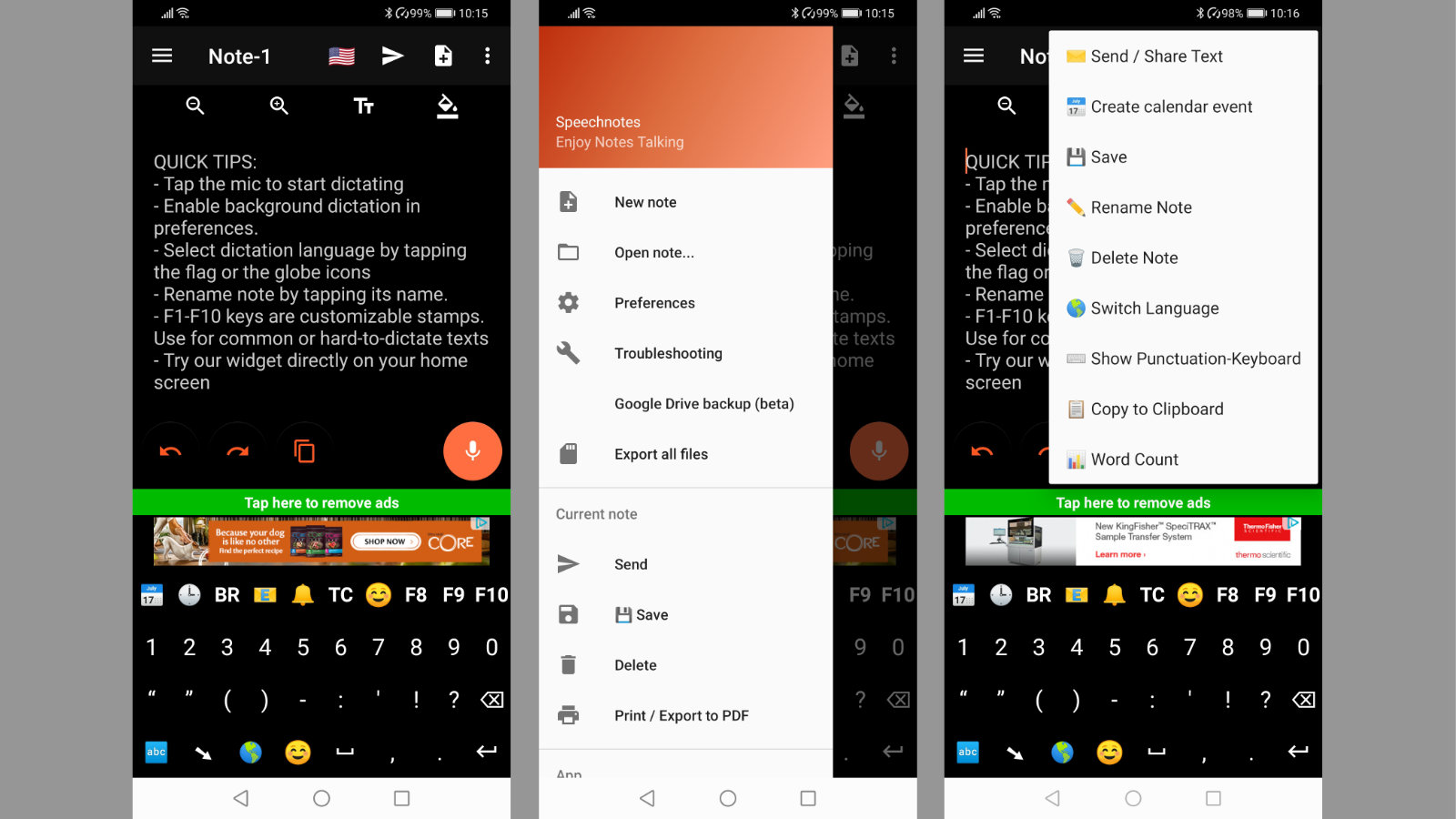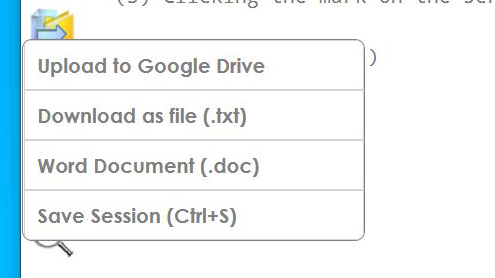Speechnotes
We’ve all loaded an app on to our mobile devices that claimed to be ‘free’, only to discover that the key functionality was disabled or effectively kneecapped.
Speechnotes confronts those cynical expectations by providing some very useful functionality that you can use for free on Android mobile devices or any computer that runs the Chrome browser.
But is this repurposing of the Google Speech engine worth your time, even it is free?
- Want to try Speechnotes? Check out the website here

Costs
Basic functionality on Speechnotes is free, and it is possible to use it without spending any money whatsoever.
For those that want to support the developer, Rehavat Ilan, Speechnotes Premium can be purchased through the Chrome Web Store for $9 per year. That enormous investment nets you the joys of continuous unlimited dictation and voice-typing, voice-typing on any website, quick editable stamps with the extension, and you don’t see adverts.
You also get Premium access to our support, and you can make feature requests. And, you can enjoy all future upgrades as they appear.
A new feature released recently is Speechnotes Files, an audio and video file transcription service that you can send files that are then transcribed by software.
That service is charged at only 10 cents per minute or less, making it highly affordable.
This service requires you add credit to then use to transcribe, and you can buy in 45 minute, 120 minute, 10 or 20 hour blocks. Each is charged at the same rate, so buying 20 hours costs $120, and ten hours $60.
For the purpose of this review, we'll be concentrating on the standard Speechnotes, but at just $4.50 to buy some credit it doesn't cost much to try out Speechnotes Files.
As a welcome gift, Speechnotes is offering 10% extra time on the first purchase.
This being a software solution, Speechnotes Files has a quoted 95% accuracy for high-quality audio, but more typically 80% is what most users should expect.
Systems that use human transcribers can often hit 98 or 99%, but they only cost much, much more per minute of audio.
Supported file formats include aac, m4a, avi, mp3, mp4, mpeg, ogg, raw, flac, wav, mov and amr, and they don’t accept physical media.

Design
As web-based applications go, this is a remarkably simple one designed to work well on just about any hardware that Chrome can run.
The application page has an icon-based menu on the left, workspace in the centre, and some reminders of how to cope with punctuation on the right.
One critical icon is the microphone, as that activates the app to listen and transcribe whatever is said to the work area.
The first time you click this icon, the app will ask for permission to access the microphone, and once that is provided, you can start.

Once you’ve completed a session, you can click another icon to get the words spoken back to you. It’s our experience that listening to typed or transcribed contents is an excellent way to find faults, as you can often notice things that scanning visually misses.
The captured words can be saved as a text file or Word document, emailed, printed, uploaded to Google Drive and are automatically saved on the system.
It’s possible to open a session and insert the cursor for changes or additions, allowing for much longer documents to be created over multiple uses.
It isn’t meant for many recording sessions, as there isn’t any folder structure to organise the stored files.
The languages supported are those that Google assistant understands, and that includes a wide range of regional English, Spanish, Portuguese and Arabic, along with various other European and Asian languages.

Android App
Alongside the Chrome browser solution, Speechnotes is also available as an Android app that should work on any modern Android phone or tablet with a microphone.
What’s slightly confusing about the Android solution is that it works differently to the Chrome app, as you can’t verbalise punctuation.
Instead, as you capture a note on the phone or tablet, a punctuation keyboard is provided on the screen where you can punch them in by hand.
This difference offers a speed advantage, but also annoying if you use the Chrome solution and then try to use this, as they require slightly different skills to master.

But the other elephant in this room is that already built into Android, and using the same core technology is a feature that allows the insertion of spoken words into any application using the microphone icon on the screen keyboard.
We also noticed that notes created on the phone do not appear on the Chrome App, or vice versa, disappointingly.

Export
A limitation with this tool is that it only has two output formats, text files and Word documents.
It is also possible to copy the text to the clipboard, enabling it to be pasted into any other suitable software that is running on the system. And, if you save to Google Drive, it will automatically use the text format rather than giving you a choice.
It seems odd, given its connections to Google, that generating a Google Doc isn't an option.
Accuracy
For our testing, we read out the classic short poem “No Man Is An Island” by John Donne, and even our first attempt was a reasonably successful exercise.
Some of the mistakes it made were down to our pronunciation since we don’t often use words like ‘promontory’ around our office.
What needs some adaptation is that for the contents to be correctly formatted all punctuation must be explicitly added. Therefore, if you want to start a new section, you must say ‘new line’ or ‘new paragraph’ for the system to do that.
There isn’t any logic that assumes long pauses are the start of a new section or grammatical logic that understands why question marks are required.
And, they don’t list all the possible punctuations it understands, but they chose to include on the list that you can add a smiley face.
The inference, if you aren’t getting it, is that this tool was probably intended for quickly generating emails without a keyboard and its fine for that purpose.
Overall, as the Google technology that it is based, it’s not incredible, but it is useable.
Security
The only security the system offers is that used by Google. Depending on how the users Google account is set up, that could range from being reasonably secure to almost negligible.
If you choose not to bother with Google two-factor authentication then your account won't be well protected, and any note you take with this system won't be either.
Final verdict
Speechnotes isn't the most sophisticated solution available, but not everyone is looking for 100% accuracy and the ability to translate cockney rhyming slang.
What Speechnotes offers is a no-frills means to turn live speech into typed words, and with that modest objective, it is mostly successful.
Our only real complaint is that the Chrome tool and the Android app demonstrate no single design thinking or even a common repository for notes taken.
Where the Chrome app has value, the inherent functionality of Android makes that version of Speechnotes a bit redundant. But if you have very occasional needs to rapidly convert spoken words into text, Speechnotes might be useful to you on both platforms.
- We've also highlighted the best transcription services
0 comments:
Post a Comment